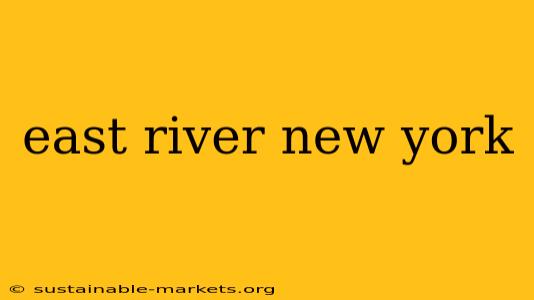The East River, while technically a tidal strait, holds a powerful symbolic and geographic significance for New York City. It's more than just water; it's a defining feature of the city's landscape, shaping its history, its economy, and its very identity. This exploration delves into the fascinating aspects of the East River, from its ecological importance to its role in the city's development.
A Geographic and Historical Overview
The East River flows roughly 16 miles (26 kilometers) from its northernmost point at Long Island Sound to the southern tip of Manhattan, where it meets the Atlantic Ocean at the Upper New York Bay. It doesn't behave like a typical river, however. Its strong tidal currents, influenced by the Atlantic Ocean, are a defining characteristic. This tidal influence has profoundly shaped its history, from early Native American settlements to the modern metropolis we know today. The river's strategic location fostered trade and facilitated the growth of New York City as a major port.
Key Historical Moments Shaped by the East River:
- Early Settlements: The river's banks provided crucial resources and access to waterways for the Lenape Native American tribes who inhabited the area long before European colonization.
- The Dutch Era: The river played a vital role in the establishment of New Amsterdam and the subsequent development of New York City under Dutch rule.
- Industrial Revolution: The East River's waterfront became a hub of industrial activity during the 19th and early 20th centuries, with numerous factories, warehouses, and shipyards lining its shores.
- The Brooklyn Bridge: The construction of the iconic Brooklyn Bridge in 1883 was a pivotal moment, connecting Manhattan and Brooklyn and fundamentally altering the city's geography and social fabric. It dramatically impacted transportation and spurred significant development on both sides of the river.
The East River's Ecology: A Complex Ecosystem
Despite its proximity to a densely populated urban area, the East River surprisingly supports a diverse ecosystem. It's home to a variety of fish species, birds, and other wildlife. However, the river's health has faced challenges due to historical pollution.
Efforts Towards Environmental Restoration:
Significant efforts have been made to improve the river's water quality and ecological health. These include initiatives aimed at reducing pollution, restoring habitats, and improving overall water quality. While significant progress has been made, ongoing monitoring and remediation efforts are crucial to maintain the positive trend.
The East River Today: Recreation and Urban Development
Today, the East River serves as a vital recreational resource and a significant element of urban planning. Its waterfront areas have undergone significant transformations in recent decades, with the creation of parks, waterfront promenades, and other public spaces.
Popular Recreational Activities along the East River:
- Kayaking and Paddleboarding: The river provides excellent opportunities for water sports, offering stunning views of the city skyline.
- Walking and Bicycling: The numerous waterfront paths and parks offer scenic routes for exercise and recreation.
- Observation Points: Numerous locations along the river offer breathtaking views of the city's iconic bridges, skyscrapers, and surrounding landscape.
The East River continues to be an integral part of New York City's identity, constantly evolving while retaining its historical significance and ecological importance. Its story is a testament to the city's dynamic nature, a blend of industrial past and modern urban revitalization. Further exploration into the specific neighborhoods and parks along its banks will reveal a deeper appreciation for this vital waterway.

